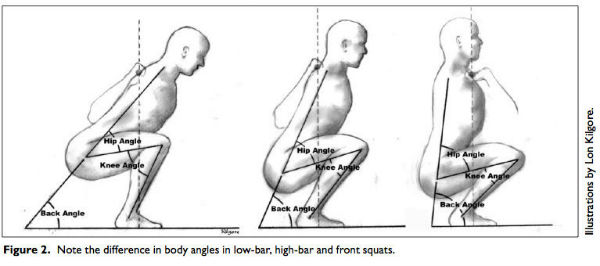
It’s no surprise that your genetics can play a role in determining how you perform exercises and your physique. While most people falsely point to bad ab genetics, bad shoulder genetics, or bad squatting genetics as an excuse for deciding not to workout themselves, genetics do come into play when we’re dealing with limb lengths.
The major bones in your lower body include your Femur and Tibia/Fibula. The respective lengths of these bones and their relation to one another can highly effect how you squat.
If you have a longer torso, with shorter Femurs and average Tibias, you will be able to stay much more upright when squatting.
On the flip side, if you have a short torso with longer legs, you will find it difficult to stay upright when squatting. At first this may seem like an issue. However, many successful bodybuilders and powerlifters have been “gifted” with these proportions. As long as your spine remains extended and your upper body is tight, it is absolutely okay to have more forward lean.
It’s easy to blame your “proportions” when in reality your form could just be terrible, or your mobility could be trash. Make sure you are working on developing hip flexibility, strength, and mobility. Doing so will ensure you build a solid “base” to build off of.
While I highly recommend that you take advantage of all kinds of squats (front vs high bar vs low bar squats), you may have an easier time performing some styles of squats over others depending on your limbs.
High bar squatting is much easier for those with long torsos. That’s why when you take a look at Olympic Weightlifting champions, they usually have very long torsos with short femurs. This allows a very strong and upright position while performing explosive movements.

A Diagram Illustrating The Biomechanics Of Squat Styles
One thing that will help anyone though, regardless of femur and torso length, is working on proper hip abduction. Often times, people are told to “force their knees out.” This is pretty common gym talk if you’ve ever asked for squat tips.
While this is better than nothing, it’s not the right approach. Instead of trying to force your knees out, you need to learn how to activate your “hip compartment.” Your hip compartment simply refers to your pelvis and all of the soft tissue/muscle surrounding it (abductors, adductors, rectus abdominals, hip flexors, psoas, glutes, other much smaller muscles).
By focusing on strengthening your hips and developing true mobility, you will “un-inhibit” your lower body and begin to feel every muscle group engage fully to help you perform any exercise, and in this case specifically, squats. The first time you perform my hip protocol, you will immediately realize how tight and inhibited your entire posterior chain has been.
But who is to blame? We sit at computers all day. We walk around with backpacks. Having proper posture is seen as “try hard.” Modern society has ruined our natural athleticism. By working against this trend, you can take advantage of the motor patterns that have been deeply engrained in our species over the course of mankind.
That’s the type of competitive advantage that will make all the difference in the world, regardless of how your limbs relate to one another.
True hip abduction in addition to engaged glutes will bring your knees out naturally. This will create “space” for your torso to fill as you go into the “hole” (the very bottom of the squat). Furthermore, just by nature of biomechanics, you will be able to stay much more upright. Bringing your feet out more will also add to this effect. Play around with your stance and positioning to see where you feel the strongest and safest.
While it’s true that the size of your upper body in relation to your legs will have a notable effect on your ability to squat, there are plenty of things you can do to tip the scale on your side. Take advantage of the tips described in this article and learn to maximize what you have.
That’s what it’s all about: making progress and getting better for you. Don’t worry about the performance of others; use them as motivation if needed, but stay grounded and do your thing.
